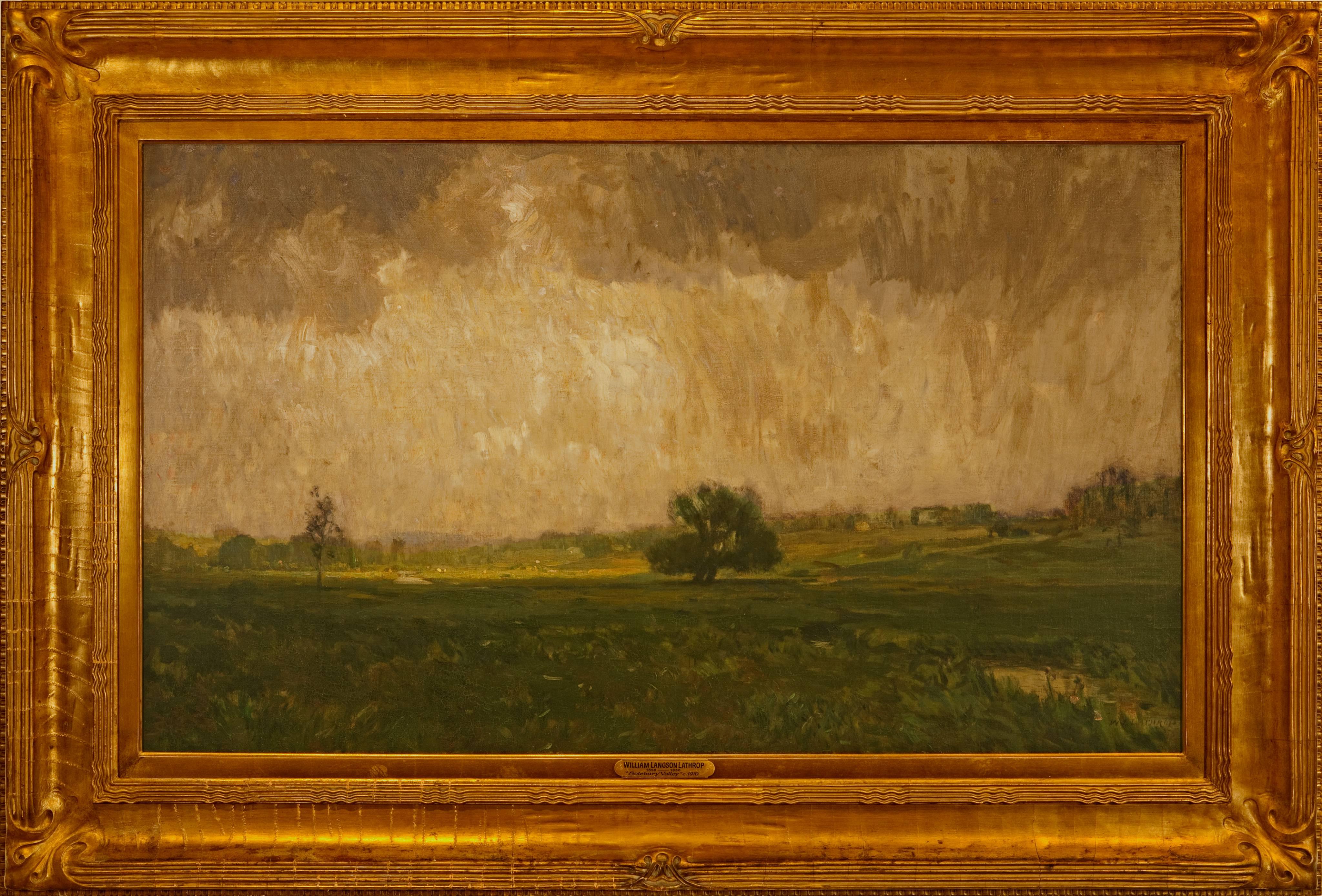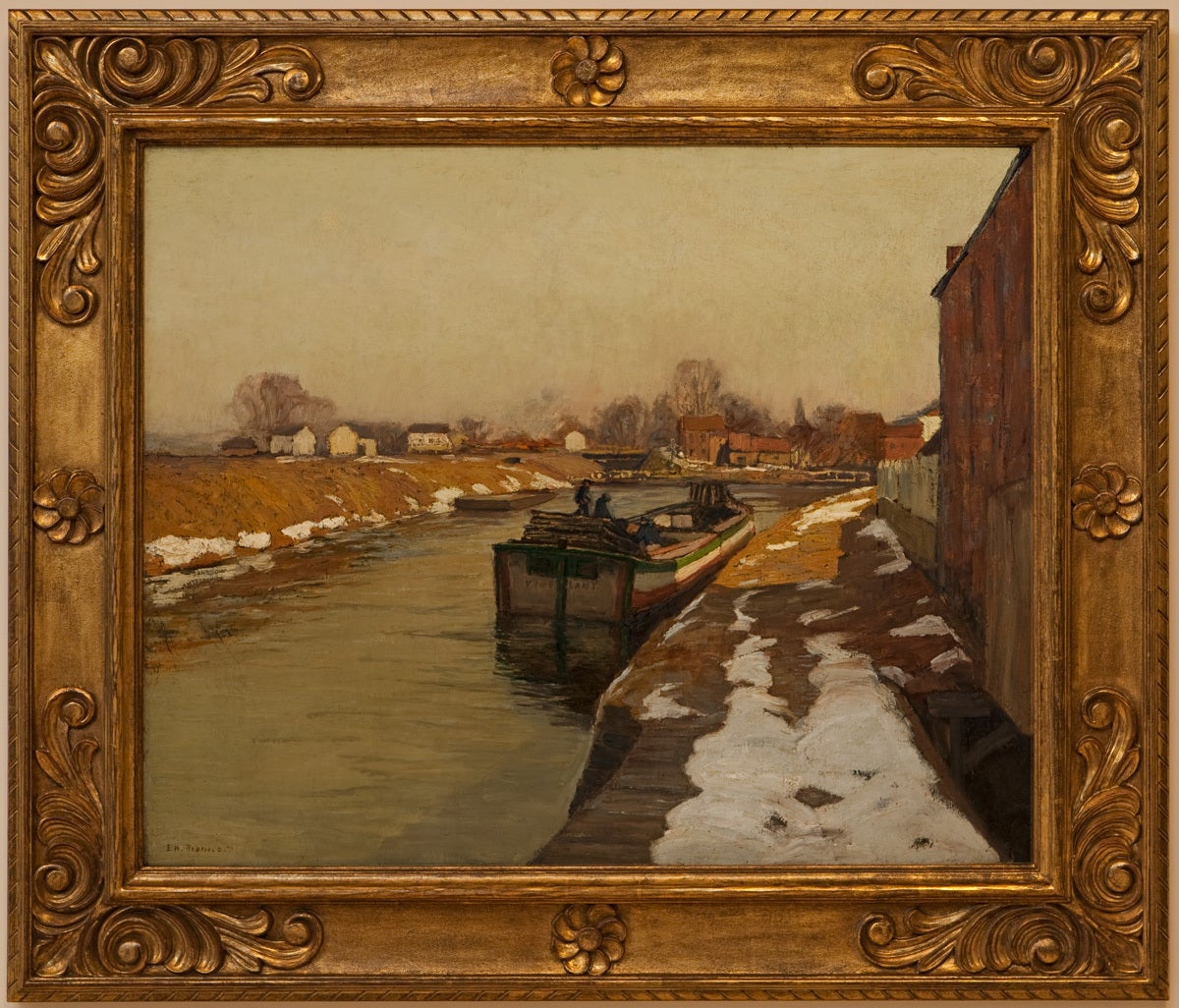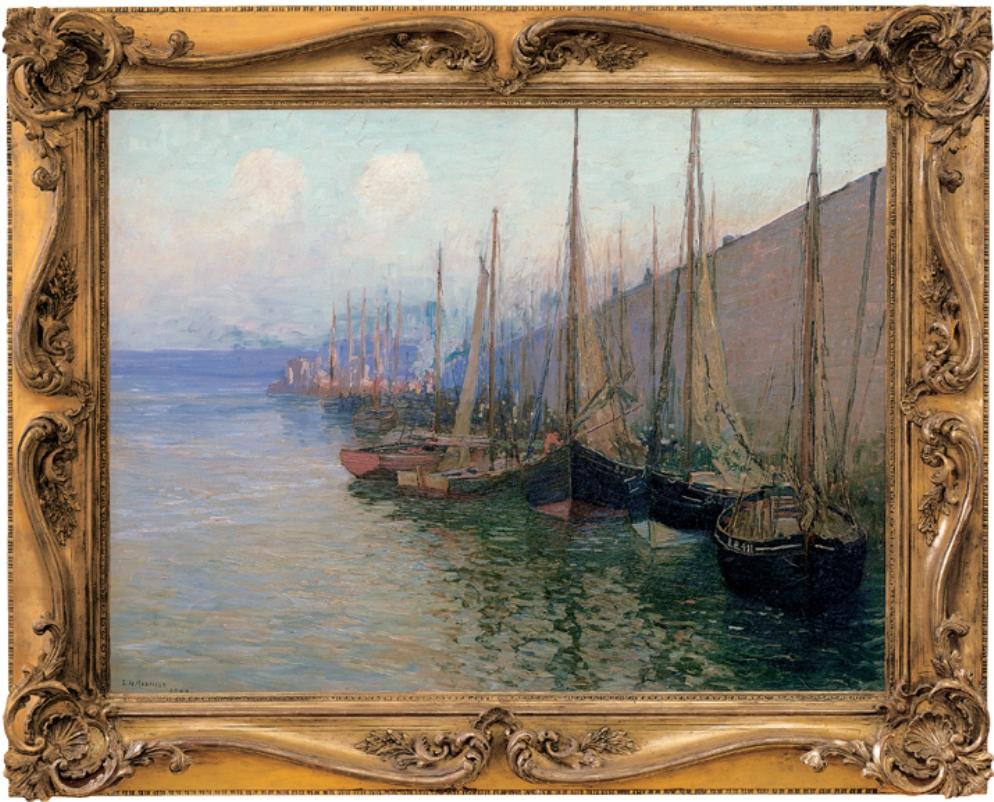Want more images or videos?
Request additional images or videos from the seller
1 of 7
Arthur Ernest BecherEarly Spring1950
1950
About the Item
Arthur Ernest Becher, 'Early Spring', oil, 1950. Signed and dated, lower right. A fine impressionist landscape, with fresh colors, on heavy illustration board, in very good, original condition, without inpainting. Framed in a period, 3 inch wide wood frame. Image size: 17 5/8 x 20 1/2 inches; outside frame dimensions: 23 3/4 x 26 5/8 inches.
ABOUT THE ARTIST
Arthur Ernst Becher was a painter and an illustrator of books and magazines. Born in Freiberg, Germany, he emigrated with his parents at the age of six to Milwaukee, Wisconsin. As a fine artist, he was known for his rural New York landscapes and historical scenes including Lincoln's Gettysburg Address.
He received early training from F.W. Heine and Robert Schade and also painted at Jones Island, a fishing village near Milwaukee. In 1902, he became a student of renowned illustrator Howard Pyle, at the Brandywine School in Chadd's Ford, Pennsylvania. Two years later he married and settled in Ardsley, New York. In 1917, the couple bought a 125-acre farm in Putnam County, New York, where he painted rural landscapes and renderings of historical events such as Lincoln's Gettysburg Address.
Pursuing a career in illustration, he gained recognition as a top magazine illustrator creating work for Scribner's, Leslie's, and Appleton's. In 1908, he went to Europe on assignment and studied privately in Germany with Otto Strutzel, who was known for landscape and animal painting. During the 1930s, his illustration moved from magazine work to books.
Becher exhibited at the Pennsylvania Academy and was a member of the Society of Illustrators.
The Delaware Art Museum holds several paintings by the artist in their permanent collection. His work was included in the 1996 exhibition N.C. Wyeth and the Brandywine School American Illustrators from the Golden Age of Illustration (1880-1960), at the American Illustrators Gallery / Judy Goffman Fine Art.
In 1959, six of his early paintings were purchased by the Common Council of Milwaukee.
- Creator:Arthur Ernest Becher (1877 - 1960)
- Creation Year:1950
- Dimensions:Height: 17.63 in (44.79 cm)Width: 20.5 in (52.07 cm)Depth: 2 in (5.08 cm)
- Medium:
- Movement & Style:
- Period:
- Condition:
- Gallery Location:Myrtle Beach, SC
- Reference Number:
About the Seller
5.0
Recognized Seller
These prestigious sellers are industry leaders and represent the highest echelon for item quality and design.
Platinum Seller
These expertly vetted sellers are 1stDibs' most experienced sellers and are rated highest by our customers.
Established in 1995
1stDibs seller since 2016
258 sales on 1stDibs
Typical response time: 1 hour
Associations
International Fine Print Dealers Association
- ShippingRetrieving quote...Ships From: Myrtle Beach, SC
- Return PolicyA return for this item may be initiated within 7 days of delivery.
More From This SellerView All
- Autumn Landscape — 1940s Post-ImpressionismLocated in Myrtle Beach, SCHenri Pierre Fortier, Untitled (Autumn Landscape), gouache, c. 1940s. Signed in ink. Inscribed 'To my Friend CLINTON R. MULFORD'. A fine, painterly watercolor, with rich, layered colors, on heavy dark brown drawing paper with approximately 1/4 inch margins; an unfinished figurative sketch...Category
1940s Impressionist Landscape Paintings
MaterialsGouache
- 'Skaters' — 1930s Woodstock, New YorkBy Emil GansoLocated in Myrtle Beach, SCEmil Ganso, 'Skaters', pochoir (color stencil) with hand painting, edition c. 50, 1938, Smith S-6. Signed in the image, lower right. A rich, painterly impression, with fresh colors, on buff wove paper; the full sheet with margins (7/8 to 1 7/8 inches), in excellent condition. Matted to museum standards, unframed. Image size 11 3/4 x 15 1/4 inches; sheet size 18 3/4 x 13 3/4 inches. An impression of this work is in the permanent collection of the Philadelphia Museum of Art. ABOUT THE ARTIST Born in Germany, Emil Ganso (1895-1941) came to the United States with his family in 1912. After settling in New York City, he found night work in a bakery and concentrated on his art in the daytime—mostly self-taught at this time, he studied only briefly at the National Academy of Design. In 1924, Ganso showed his drawings to Carl Zigrosser, who organized the artist’s first solo exhibition, at the Weyhe Gallery. Soon afterward, Ganso enrolled in Eugene Fitsch’s printmaking class at the Art Students League. Although he considered himself primarily a painter, Ganso made prints in all media, including relief and stencil prints and complex intaglios, and even experimented with color lithography in the late 1920s. He also developed, with an engineer, the design and fabrication of an innovative etching press. In 1926, Ganso attended the Art Students League summer session in Woodstock, New York. There, he met Jules Pascin, and the two artists began a close friendship, briefly sharing a studio. Ganso followed Pascin to Europe in 1928. In 1929, Ganso returned to New York and showed his work regularly in group exhibitions. He continued working in Woodstock in the summer months, often printing lithographs for other artists. The Cleveland Print Club...Category
1930s American Impressionist Landscape Prints
MaterialsGouache, Stencil
- Grand Central, NightBy Walter TittleLocated in Myrtle Beach, SCWalter Tittle, 'Grand Central Night', drypoint, edition not stated, c. 1920s. Signed in pencil. Titled, and annotated '36.00' and with the inventory numb...Category
1920s American Impressionist Landscape Prints
MaterialsDrypoint
- The Plaza, Sunset GlowBy Walter TittleLocated in Myrtle Beach, SC'The Plaza, Sunset Glow', drypoint, c. 1920s, edition not stated. Signed in pencil and initialed in the plate, lower right. Titled 'The Plaza, Sunset' and annotated 'no. 165' in ink, in the bottom left sheet corner. A superb, luminous impression in dark brown ink, with selectively wiped plate tone; on cream wove paper; the full sheet with margins (1 to 2 1/4 inches). Pale tape stains on the top sheet edge, recto, well away from the image, otherwise in excellent condition. Matted to museum standards, unframed. A view across 'The Pond' in New York City's Central Park, toward Grand Army Plaza...Category
1920s American Impressionist Landscape Prints
MaterialsDrypoint
- 'Grand Central Station' — 1920s New York CityBy Otto KuhlerLocated in Myrtle Beach, SCOtto Kuhler, 'Grand Central Station', etching and drypoint, 1927, edition c. 50, Kennedy 27. Signed and titled in pencil. A superb, richly-inked impression, in brown/black ink, with ...Category
1920s American Impressionist Figurative Prints
MaterialsDrypoint, Etching
- 'Ship Rock, New Mexico' —By Albert GrollLocated in Myrtle Beach, SCAlbert Lorey Groll, 'Ship Rock, New Mexico', etching, c. 1910. Signed and titled in pencil. A fine, richly-inked impression on cream, wove paper, the full sheet with margins (1 to 1 3/8 inches); a slight paper defect in the center-left margin, away from the image, otherwise in excellent condition. Image size 7 7/8 x 10 inches (200 x 254 mm); sheet size 10 1/8 x 12 15/16 inches (257 x 329 mm). Scarce. Provenance: Ex. collection Kennedy Galleries, in their original gallery mat with label attached. ABOUT THE ARTIST Albert Lorey Groll (1866-1910) was born in New York in 1866, the son of a pharmacist immigrant from Darmstadt, Germany. During his early years, he traveled to Europe to study at the Royal Academy of Fine Arts in Munich under Nicholas Gysis and Ludwig von Löfftz. He further pursued his studies in London and at the Royal Academy of Fine Arts in Antwerp, Belgium. Groll returned to New York in 1895 and moved from figure to landscape painting while expanding his interests to printmaking. In 1904 Groll made the first of several trips to the American Southwest, traveling to Arizona with ethnographer Stewart Culin of the Brooklyn Museum. Later he went to New Mexico with his friend, the artist and illustrator William Robinson Leigh (see our 1stDibs listing no. LU53239015112 ). He focused on impressionistic scenes of Native American lands. The Laguna Pueblo people admired Groll's paintings, honoring him with the name "Chief Bald Head Eagle Eye." Groll kept a studio in the Gainsborough Studios in Manhattan and won several awards for his work in Arizona and New York, including the Salmagundi Club Shaw Prize in 1904 and a gold medal at the Pennsylvania Academy of Fine Arts in 1906. He was also awarded the George Inness gold medal from the National Academy of Design in 1912 for his painting of Lake Louise in the Canadian Rockies. In 1910 he was elected into the National Academy of Design and, in 1919, an associate member of the Taos Society...Category
1910s American Impressionist Landscape Prints
MaterialsEtching
You May Also Like
- "Alley Fiends"By John R. GrabachLocated in Lambertville, NJJim’s of Lambertville is proud to offer this artwork by: John R. Grabach (1886 - 1981) John Grabach was a highly regarded New Jersey artist, teacher, and author of the classic text...Category
1930s American Impressionist Landscape Paintings
MaterialsCanvas, Oil
- "Forest Strongholds"By John F. CarlsonLocated in Lambertville, NJSigned lower right. Complemented by a hand carved and gilt frame. Exhibited at the National Academy of Design, 1928Category
20th Century American Impressionist Landscape Paintings
MaterialsCanvas, Oil
- "Solebury Valley"By William Langson LathropLocated in Lambertville, NJSigned lower right. Complemented by a period frame. William L. Lathrop (1859-1938) Deemed “Father of the New Hope Art Colony”, William Langson Lathrop was born in Warren, Illinois. He was largely self-taught, having only studied briefly with William Merritt Chase in 1887, at the Art Students League. Lathrop first moved east in the early 1880s, and took a job at the Photoengraving Company in New York City. While there, he befriended a fellow employee, Henry B. Snell. The two men became lifelong friends and ultimately, both would be considered central figures among the New Hope Art Colony. Lathrop's early years as an artist were ones of continuing struggle. His efforts to break through in the New York art scene seemed futile, so he scraped enough money together to travel to Europe with Henry Snell in1888. There he met and married an English girl, Annie Burt. Upon returning to New York, he tried his hand at etching, making tools from old saw blades...Category
1910s American Impressionist Landscape Paintings
MaterialsCanvas, Oil
- Winter MoonlightBy George William SotterLocated in Lambertville, NJsigned lower rightCategory
1910s American Impressionist Landscape Paintings
MaterialsCanvas, Oil
- "The Canal"By Edward Willis RedfieldLocated in Lambertville, NJJim’s of Lambertville is proud to offer this artwork. Signed lower left. Complemented by a hand carved and gilt frame. Illustrated in "Edward Redfield: Just Values and Fine Seeing" by Constance Kimmerle and the Pennsylvania Academy of the Fine Arts's Exhibition of Paintings by Edward Redfield (April 17 to May 16, 1909) brochure Edward Willis Redfield (1869 - 1965) Edward W. Redfield was born in Bridgeville, Delaware, moving to Philadelphia as a young child. Determined to be an artist from an early age, he studied at the Spring Garden Institute and the Franklin Institute before entering the Pennsylvania Academy from 1887 to 1889, where he studied under Thomas Anshutz, James Kelly, and Thomas Hovenden. Along with his friend and fellow artist, Robert Henri, he traveled abroad in 1889 and studied at the Academie Julian in Paris under William Bouguereau and Tony Robert-Fleury. While in France, Redfield met Elise Deligant, the daughter of an innkeeper, and married in London in 1893. Upon his return to the United States, Redfield and his wife settled in Glenside, Pennsylvania. He remained there until 1898, at which time he moved his family to Center Bridge, a town several miles north of New Hope along the Delaware River. Redfield painted prolifically in the 1890s but it was not until the beginning of the twentieth century that he would develop the bold impressionist style that defined his career. As Redfield’s international reputation spread, many young artists gravitated to New Hope as he was a great inspiration and an iconic role model. Edward Redfield remained in Center Bridge throughout his long life, fathering his six children there. Around 1905 and 1906, Redfield’s style was coming into its own, employing thick vigorous brush strokes tightly woven and layered with a multitude of colors. These large plein-air canvases define the essence of Pennsylvania Impressionism. By 1907, Redfield had perfected his craft and, from this point forward, was creating some of his finest work. Redfield would once again return to France where he painted a small but important body of work between 1907 and 1908. While there, he received an Honorable Mention from the Paris Salon for one of these canvases. In 1910 he was awarded a Gold Medal at the prestigious Buenos Aires Exposition and at the Panama-Pacific Exposition of 1915 in San Francisco, an entire gallery was dedicated for twenty-one of his paintings. Since Redfield painted for Exhibition with the intent to win medals, his best effort often went into his larger paintings. Although he also painted many fine smaller pictures, virtually all of his works were of major award-winning canvas sizes of 38x50 or 50x56 inches. If one were to assign a period of Redfield’s work that was representative of his “best period”, it would have to be from 1907 to 1925. Although he was capable of creating masterpieces though the late 1940s, his style fully matured by 1907 and most work from then through the early twenties was of consistently high quality. In the later 1920s and through the 1930s and 1940s, he was like most other great artists, creating some paintings that were superb examples and others that were of more ordinary quality. Redfield earned an international reputation at a young age, known for accurately recording nature with his canvases and painting virtually all of his work outdoors; Redfield was one of a rare breed. He was regarded as the pioneer of impressionist winter landscape painting in America, having few if any equals. Redfield spent summers in Maine, first at Boothbay Harbor and beginning in the 1920s, on Monhegan Island. There he painted colorful marine and coastal scenes as well as the island’s landscape and fishing shacks. He remained active painting and making Windsor style furniture...Category
Early 1900s American Impressionist Landscape Paintings
MaterialsCanvas, Oil
- "In Port"By Edward Willis RedfieldLocated in Lambertville, NJJim’s of Lambertville is proud to offer this artwork by: Edward Willis Redfield (1869 - 1965) Edward W. Redfield was born in Bridgeville, Delaware, moving to Philadelphia as a young child. Determined to be an artist from an early age, he studied at the Spring Garden Institute and the Franklin Institute before entering the Pennsylvania Academy from 1887 to 1889, where he studied under Thomas Anshutz, James Kelly, and Thomas Hovenden. Along with his friend and fellow artist, Robert Henri, he traveled abroad in 1889 and studied at the Academie Julian in Paris under William Bouguereau and Tony Robert-Fleury. While in France, Redfield met Elise Deligant, the daughter of an innkeeper, and married in London in 1893. Upon his return to the United States, Redfield and his wife settled in Glenside, Pennsylvania. He remained there until 1898, at which time he moved his family to Center Bridge, a town several miles north of New Hope along the Delaware River. Redfield painted prolifically in the 1890s but it was not until the beginning of the twentieth century that he would develop the bold impressionist style that defined his career. As Redfield’s international reputation spread, many young artists gravitated to New Hope as he was a great inspiration and an iconic role model. Edward Redfield remained in Center Bridge throughout his long life, fathering his six children there. Around 1905 and 1906, Redfield’s style was coming into its own, employing thick vigorous brush strokes tightly woven and layered with a multitude of colors. These large plein-air canvases define the essence of Pennsylvania Impressionism. By 1907, Redfield had perfected his craft and, from this point forward, was creating some of his finest work. Redfield would once again return to France where he painted a small but important body of work between 1907 and 1908. While there, he received an Honorable Mention from the Paris Salon for one of these canvases. In 1910 he was awarded a Gold Medal at the prestigious Buenos Aires Exposition and at the Panama-Pacific Exposition of 1915 in San Francisco, an entire gallery was dedicated for twenty-one of his paintings. Since Redfield painted for Exhibition with the intent to win medals, his best effort often went into his larger paintings. Although he also painted many fine smaller pictures, virtually all of his works were of major award-winning canvas sizes of 38x50 or 50x56 inches. If one were to assign a period of Redfield’s work that was representative of his “best period”, it would have to be from 1907 to 1925. Although he was capable of creating masterpieces though the late 1940s, his style fully matured by 1907 and most work from then through the early twenties was of consistently high quality. In the later 1920s and through the 1930s and 1940s, he was like most other great artists, creating some paintings that were superb examples and others that were of more ordinary quality. Redfield earned an international reputation at a young age, known for accurately recording nature with his canvases and painting virtually all of his work outdoors; Redfield was one of a rare breed. He was regarded as the pioneer of impressionist winter landscape painting in America, having few if any equals. Redfield spent summers in Maine, first at Boothbay Harbor and beginning in the 1920s, on Monhegan Island. There he painted colorful marine and coastal scenes as well as the island’s landscape and fishing shacks. He remained active painting and making Windsor style furniture...Category
Early 1900s American Impressionist Landscape Paintings
MaterialsCanvas, Oil
Recently Viewed
View AllMore Ways To Browse
Vintage Images Of Spring
German Early 20th Century Painting
Vintage Couple Illustration
1930s Magazine Illustration
Golden Age Of Illustration
Fishing Illustration
Wyeth Originals
Scribners Magazine
Vintage Fishing Illustration
Robert Leslie
Ernst N
Howard Jones
Judy Woods
Ernest Jones
Appleton Brown
Books Pyle
Otto Schade
Antique American Modernist Art





